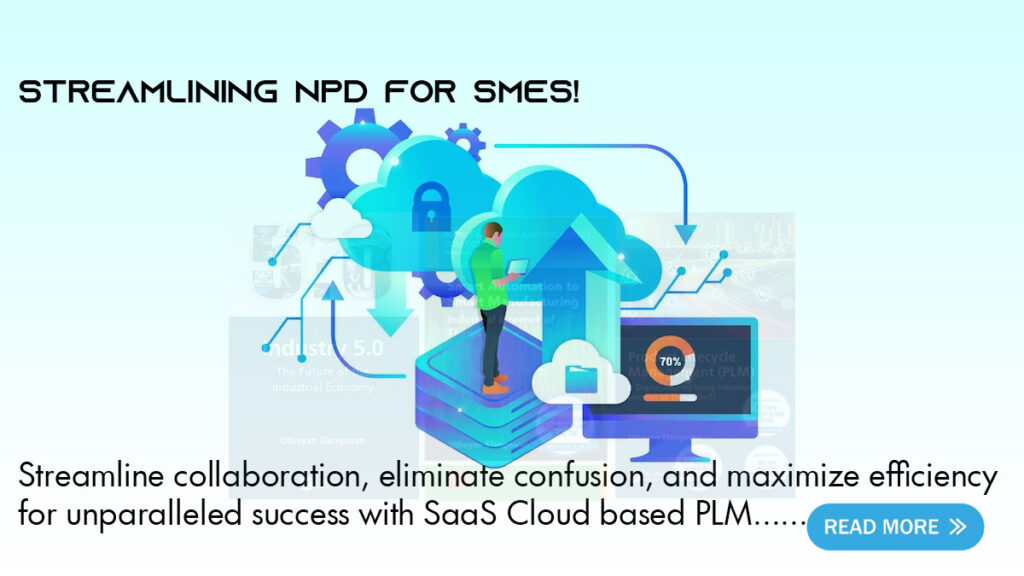Streamlining NPD Collaboration: Mitigating Confusion and Maximizing Efficiency with Cloud PLM!

Introduction:
In the era of interconnected business world, effective collaboration is key to successful new product development (NPD). However, the reliance on disparate tools and file storage systems such as Excel spreadsheets and shared drives for storing Bills of Materials (BOMs) and Computer-Aided Design (CAD) documents can lead to confusion and inefficiency among NPD team members. To address these challenges, implementing a cloud-based Product Lifecycle Management (PLM) system offers a comprehensive solution that reduces total cost of ownership (TCO) and maximizes return on investment (ROI) and return on value (ROV). This article explores the drawbacks of traditional approaches and highlights the benefits of adopting a cloud-based PLM solution.
Drawbacks of Storing BOMs in Excel or Spreadsheets:
Using Excel or spreadsheets as the primary means for managing BOMs poses several challenges in NPD collaboration. Firstly, spreadsheets lack version control and audit trails, making it difficult to track changes and maintain a single source of truth. This can lead to confusion and errors, especially when multiple team members are working concurrently. Secondly, spreadsheets are prone to data inconsistencies, as updates may not be synchronized across all instances, resulting in discrepancies between BOM versions. Lastly, spreadsheets limit accessibility and hinder real-time collaboration, as they often reside on local drives or email attachments, preventing seamless cross-functional collaboration across geographically dispersed teams.
Confusion Caused by CAD Documents in Shared Drives:
Similarly, relying on shared drives for storing CAD documents can create confusion and inefficiencies within NPD teams. Shared drives lack robust search capabilities, making it challenging to locate specific CAD files efficiently. Furthermore, without proper metadata management, team members may struggle to determine the latest version of a CAD document, leading to errors and rework. Additionally, shared drives often lack the ability to control access rights, exposing sensitive design information to unauthorized personnel. These limitations can impede the smooth flow of information, delay decision-making, and result in costly mistakes.
Mitigating Confusion:
Adopting a cloud PLM system can significantly mitigate the challenges associated with storing BOMs in Excel and CAD documents in shared drives. Here are some ways in which a cloud-based PLM solution can streamline NPD collaboration:
- Centralized Data Repository: A cloud-based PLM platform provides a centralized repository for all product-related information, including BOMs and CAD documents. This ensures that all team members access the latest, up-to-date information, eliminating confusion caused by multiple versions and disparate file locations.
- Version Control and Audit Trails: With a cloud-based PLM system, changes to BOMs and CAD documents are automatically tracked, and a detailed audit trail is maintained. This enables NPD teams to view the history of modifications, understand who made the changes, and ensure accountability and traceability.
- Real-Time Collaboration: Cloud-based PLM platforms facilitate real-time collaboration, allowing team members to work simultaneously on BOMs and CAD documents. This eliminates the need for manual consolidation and exchange of files, enhancing productivity and reducing delays in the development process.
- Enhanced Search and Metadata Management: Cloud-based PLM solutions offer advanced search capabilities, enabling easy and quick retrieval of specific BOMs or CAD files. Effective metadata management ensures that relevant information about BOMs and CAD documents, such as part numbers, revisions, and status, is readily available, reducing the risk of confusion and errors.
- Controlled Access and Security: Cloud-based PLM systems allow administrators to define access rights and permissions, ensuring that sensitive design information is only accessible to authorized personnel. This enhances data security and protects intellectual property, minimizing the risk of data breaches or unauthorized modifications.
Reducing TCO:
Implementing a cloud-based PLM solution can have a significant impact on reducing TCO and maximizing ROI and ROV. By streamlining collaboration, reducing errors, and improving productivity, NPD teams can achieve cost savings through reduced rework and improved time-to-market. Furthermore, a cloud-based PLM system eliminates the need for expensive infrastructure investments and ongoing maintenance, resulting in lower IT costs and increased scalability. The accessibility and real-time collaboration features of cloud-based PLM also foster innovation and enable faster decision-making, leading to increased customer satisfaction and competitive advantage, thereby maximizing ROI and ROV.
Conclusion:
The drawbacks of storing BOMs in Excel spreadsheets and CAD documents in shared drives can hinder collaboration and introduce confusion and inefficiency in NPD projects. Adopting a cloud-based PLM solution offers a comprehensive remedy, enabling centralized data management, version control, real-time collaboration, enhanced search capabilities, and controlled access. This leads to streamlined processes, reduced errors, improved productivity, and enhanced data security. By leveraging cloud-based PLM, organizations can significantly reduce TCO, maximize ROI and ROV, and empower their NPD teams to achieve greater success in a competitive market landscape.
Take your SME to new heights with Neel SMARTEC! Harness the power of OpenBOM, the cutting-edge cloud PLM & PDM platform, and revolutionize the way you manage files, parts, BOMs, inventory, and purchases. From seamless collaboration to streamlined workflows, Neel SMARTEC has got you covered. Don’t wait another moment – contact us today and embark on a journey towards optimized efficiency and unparalleled success. Transform your business with Neel SMARTEC’s – your pathway to innovation starts now!

